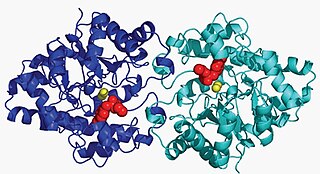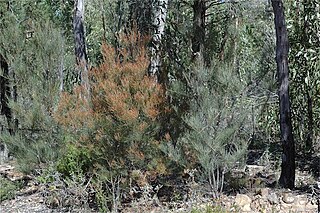Hymenolepiasis is infestation by one of two species of tapeworm: Hymenolepis nana or H. diminuta. Alternative names are dwarf tapeworm infection and rat tapeworm infection. The disease is a type of helminthiasis which is classified as a neglected tropical disease.

The Hymenolepididae are family of cyclophyllid tapeworms. Their characteristic feature is the small number of testes. The unilateral genital pores and large external seminal vesicle allow for easy recognition. Most species are small, transparent, and easy to study. The family contains over 90 genera with over 900 species, having as their definitive host birds or mammals. Most reside in the intestines of their definitive hosts. The majority of species with known lifecycles have arthropods as intermediate hosts.

Hymenolepis diminuta, also known as rat tapeworm, is a species of Hymenolepis tapeworm that causes hymenolepiasis. It has slightly bigger eggs and proglottids than H. nana and infects mammals using insects as intermediate hosts. The adult structure is 20 to 60 cm long and the mature proglottid is similar to that of H. nana, except it is larger.
Shorea agamii is a species of plant in the family Dipterocarpaceae. The species is named after J. Agama a one time forest officier in the Sabah Forestry Department. Two subspecies are recognised subsp. agamii and subsp diminuta. The subspecies name diminuta is derived from Latin and refers to the smaller leaves of this subspecies.

Aryldialkylphosphatase is a metalloenzyme that hydrolyzes the triester linkage found in organophosphate insecticides:

Glyphoturris is a genus of sea snails, marine gastropod mollusks in the family Mangeliidae.

Grevillea diminuta is a species of flowering plant in the family Proteaceae and is endemic to eastern Australia. It is a small, spreading shrub with elliptic to egg-shaped leaves and cylindrical to dome-shaped groups of reddish-brown flowers.

Pycnoclavella diminuta, known as the white-spotted sea squirt, white-spot ascidian, and white-spotted ascidian, is a species of tunicate, in the genus Pycnoclavella. Like all ascidians, these sessile animals are filter feeders.

Leptogenys diminuta is a species of ant of the subfamily Ponerinae. Twelve subspecies are recognized.
Semisulcospira diminuta is a species of freshwater snail with an operculum, an aquatic gastropod mollusk in the family Semisulcospiridae.

Allocasuarina diminuta is a species of flowering plant in the family Casuarinaceae and is endemic to eastern New South Wales. It is a dioecious or monoecious shrub or small tree that has branchlets up to 230 mm (9.1 in) long, the leaves reduced to scales in whorls of six to ten, the fruiting cones 5–20 mm (0.20–0.79 in) long containing winged seeds (samaras) 3.5–5.0 mm (0.14–0.20 in) long.

Oxyinae is subfamily of grasshoppers in the family Acrididae. Species are distributed throughout Africa and Australasia.

Oxyini is one of two tribes of grasshoppers in the subfamily Oxyinae. Some genera previously listed here are now placed in the subfamilies Caryandinae and Hemiacridinae.

Eucalyptus diminuta, commonly known as the spring mallee, is a species of mallee that is endemic to south-west of Western Australia. It has smooth, silvery to greyish bark, sometimes with rough flaky bark near the base, lance-shaped adult leaves, pendulous, elongated flower buds arranged in groups of seven, creamy white flowers and cup-shaped to bell-shaped fruit.

Moellendorffia is a gastropod mollusc genus of the family Camaenidae. Members of this genus appear only in East Asia, spanning north from Japan, Mainland China, Hong Kong, Vietnam and Indonesia.

Pterostylis diminuta, commonly known as the small-flowered leafy greenhood, is a plant in the orchid family Orchidaceae and is endemic to Victoria. As with similar greenhoods, the flowering plants differ from those that are not flowering. The non-flowering plants have a rosette of leaves flat on the ground but the flowering plants have up to twelve small, partly green, partly translucent flowers and lack a rosette.
Caenis diminuta is a species of small squaregilled mayfly in the family Caenidae. It is found in Central America and North America.
Procotes is a monotypic moth genus in the Zygaenidae family described by Arthur Gardiner Butler in 1876. Its single species, Procotes diminuta, described by Francis Walker in 1854, is found in Sri Lanka.

Diadasia diminuta, the globe mallow bee, is a species of chimney bee in the family Apidae. It is found in Central America and North America.
Carex diminuta is a tussock-forming species of perennial sedge in the family Cyperaceae. It is native to parts of China.














